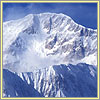

|
|
Mount McKinley
North America
McKinley is the northernmost major peak in the world, covered
by the largest expanse of snow and ice on any mountain.
Temperatures on McKinley, which can fall to minus 150°
with wind chill, are among the coldest anywhere on Earth.
Location: Denali National Park and Preserve, Alaska
Elevation: 20,320 feet
First ascent: Walter Harper, Henry Karstens, Hudson Stuck
& Robert Tatum, U.S., 1913
About the name: Named after American President William
McKinley. Most mountaineers and Alaskans call this mountain
Denali, which in the local Athabascan language means "The High
One." Discussion remains of officially renaming the peak
Denali.
|
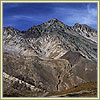

|
|
Cerro Aconcagua
South America
The second highest of the Seven Summits, Aconcagua is
sometimes called a mountaineering "bargain" because of its
disproportionate ratio of elevation to effort. Climbers have
tackled it on skis, mountain bikes, even motorcycles. However,
this mountain should be no means be taken for granted. An
average expedition takes 18 days, and many people have died
from freezing, altitude sickness, and other causes while
attempting to scale it.
Location: Cordillera Andes, Argentina
Elevation: 22,835 feet
First ascent: Matthew Zurbriggen, Swiss guide on an English
expedition, 1897
About the name: Aconcagua comes from the traditional Incan
name, Ackon Cahuak, meaning "White Sentinel."
|


|
|
Gora Elbrus
Europe
The twin-peaked Elbrus (or "Gora Elbrus," using the Russian
word for mountain) offers climbers a formidable challenge.
Moist air rising off the nearby Black Sea produces
impenetrable blizzards and frigid temperatures, feeding the
mountain's maze of 22 glaciers and fortifying its
56-square-mile ice cap, which is hundreds of feet deep in some
areas.
Location: Caucasus Mountains, Georgia
Elevation: 18,481 feet
First ascent: Killar Khasirov, Circassian tribe, 1829
(unconfirmed); Douglas W. Freshfield, Adolphus W. Moore &
C.C. Tucker, England, with French guide Françoise
Devouassoud, 1868 (confirmed)
About the name: Also called Elborus locally, the derivation of
this mountain's name is not known.
|
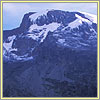

|
|
Mount Kilimanjaro
Africa
Kilimanjaro is topped by three dormant volcanic summits, Kibo
(19,340 feet), Mawenzi, (16,896 feet), and Shira (13,140
feet). Its fabled glaciers, some of the very few on the
African continent, are rapidly disappearing.
Location: Kilimanjaro National Park, Tanzania
Elevation: 19,340 feet
First ascent: Hans Meyer, Germany & Luwig Portscheller,
Austria, 1889
About the name: The derivation of "Kilimanjaro" is unknown,
but it might come from two Swahili words, "Kilima" and
"Njaro," which together mean to "Shining Mountain."
|
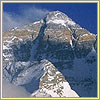

|
|
Mount Everest
Asia
The tallest mountain in the world, Everest looms large over
the Nepal/Tibet border in the Mahalangur Himal, a segment of
the 1,500-mile-long Himalayan mountain range. The Himalayas
are home to four of the world's fourteen peaks over 26,000
feet tall.
Location: Mahalangur Himal, Nepal/Tibet
Elevation: 29,028 feet
First ascent: Sir Edmund Hillary, New Zealand & Tenzig
Norgay, Nepal, 1953
About the name: Named after Sir George Everest, British
Surveyor General in India, mid-19th century. Everest is known
by Tibetans as Chomolungma, "Goddess Mother of Earth" and by
Nepalese as Sagarmatha, "Goddess of the Sky."
|


|
|
Puncak Jaya
Australasia
This limestone peak, perennially shrouded in mist, made slick
by rain, and pelted with hail, rises out of an area of thick
jungles and mangrove swamps in Irian Jaya, the western half of
the island of New Guinea. Australasia, which geographers
consider the true Down Under continent, also includes
Australia, New Zealand, and the island nations of the South
Pacific.
Location: Snow Mountains, Irian Jaya
Elevation: 16,020 feet
First ascent: Heinrich Harrer, Austria; Bert Huizinga, The
Netherlands; Russel Kippax, Australia & Philip Temple, New
Zealand, 1962
About the name: Puncak Jaya means "Victory Peak" in
Indonesian. The mountain is also known as Carstensz Pyramid,
named for Dutch explorer Jan Carstensz, who was the first
European to sight the mountain in the 17th century, and for
its pyramid-like shape.
|
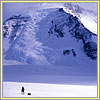

|
|
Vinson Massif
Antarctica
Vinson dominates a landscape of stark purity, where nothing
other than ice, snow, and barren rock stretch as far as the
eye can see. Antarctica, with Vinson at its ceiling, is the
coldest and driest desert on Earth, receiving less than two
inches of precipitation per year. Most of the snow on the
mountain arrived there on the wind, blown from other parts of
the continent.
Location: Sentinel Range, Ellsworth Mountains
Elevation: 16,067 feet
First ascent: Nicholas Clinch, J. Barry Corbet, John P. Evans,
Eiichi Fukushima, Charles Hollister, William E. Long, Brian S.
Marts, Peter K. Schoening, Samuel C. Silverstein & Richard
W. Wahlstrom, U.S., 1966
About the name: Named after Carl Vinson, a U.S. Congressman
from Georgia (1914 to 1965) who supported Antarctic research.
A "massif" is a large mountain that forms an independent
portion of a mountain range.
|

|

|

